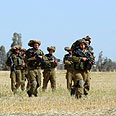
Givati soldiers near Gaza (Archive photo)
צילום: AFP
Where did the army go?
IDF used to serve as buffer between shooters, Israeli civilians, but this has changed
Longtime Gaza region residents have been on Israel’s frontlines for dozens of years now. The Qassams and mortar shells in Nahal Oz, Nir Am, and Kissufim are the continuation of the infiltrations and landmines that residents coped with generations ago.
Yet there are two differences between the security distress of the past and what is going on today.
The first difference is that back then, residents in the area drew strength from the home front, which displayed solidarity and supported the front. Now, those who were able to hold on feel that they have been abandoned by the State and left to fend for themselves; a front without a home front.
The second difference is even sadder: The IDF, which once served as a buffer between residents and the border, is now hiding behind the residents’ backs. Area residents watch with sad eyes how military units desert their outposts and move to bases that are far away from the Qassam range, leaving the communities and their residents as a frontal shield positioned in front of the army.
Most Gaza-region communities make a living from agriculture. Once the area was an empty desert, but the residents changed reality. Those who dare visit the area these days will discover spectacular green pastures and tens of thousands of dunams used for growing plentiful crops such as potatoes, carrots, peanuts, and seeds. This abundance is produced by people; residents who built their homes there.
Army no longer a buffer
There, right next to the border, they work their fields from morning till evening, plow, sow, water, and pick. There is much work there; hard work. They are being fired at, sometimes gunfire and sometimes mortar fire, they are being ambushed, and traps are being laid for them, just like it used to be dozens of years ago; however, back then the army was the buffer between the shooters and the farmers.
Today, the army is no longer a buffer. On occasion, when the Palestinians fire, the army arrives, as long as the soldiers are well protected: A protective vest, a helmet, and other protection means. The soldiers arrive in armored vehicles. If an armored vehicle malfunctions, heaven forbid, the troops won’t be sent int. The farmers continue to work the fields on their own.
How have the tables turned this way? How is it that on the front lines we see civilians working while being exposed to the fire, while the army, which is well protected from head to toe, safeguards itself behind them?










